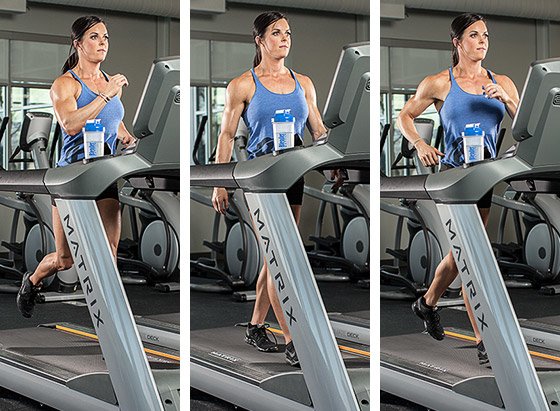For years, marathon cardio sessions were 'mandatory' for women who wanted to lower their body fat for competition. These sessions were long and boring... nothing like 2 hours on a recumbent bike! No one seemed to notice that athletes who trained using short duration, intense workouts (such as sprinters) were leaner and more muscular than athletes who did much higher volumes of cardio (ex. long distance runners).

Part 1: Interval Training
Research now shows us that higher intensity training, such as interval training, can deliver the same results in much less time than traditional longer duration cardio sessions.
Many studies prove the effectiveness of high intensity training:
The first major study was conducted in 1985. The American Journal of Clinical Nutrition determined that high-intensity training increases metabolism for up to 24 hours after training.
With lower intensity training (steady-state cardio) metabolism returned to normal shortly after the exercises session ended. (It is now an accepted fact that the rate at which you burn fat depends more on how many calories you burn in the hours following your workout as opposed to the number of calories you burn during your workout).
As recently as December 2006, researchers at the University of Guelph in Canada found that two weeks of interval training done on alternate days can increase metabolism by 36% in women.
What Is Interval Training?
Interval training is characterized by short, intense speed/effort increases during your cardio session, followed by longer duration 'recovery' period in which you return to your usual pace on whatever piece of cardio equipment you are using.
For example, let's say you normally run at 5.0 on the treadmill for 40 minutes. To introduce intervals into your session, you would (once you are warmed up) sprint for 20-30 second 'intervals' (at a higher speed than your usual 5.0), then reduce the speed back to 5.0 (or slightly lower) for 2-3 minutes, depending on your conditioning. This would be repeated for half of your normal cardio time (20 minutes).
That's all there is to it, It seems simple but if you've never tried it, be prepared for an extremely intense workout. Research shows that proper interval training can get you the same results in half the time of steady-state/lower intensity cardio.
This can be done on any piece of cardio equipment. The spin bike is excellent for intervals because of the ease at which you can control the speed/tension.
You should be out of breath at the end of each interval segment. If you can talk comfortably, you are not pushing yourself hard enough! Just remember to take it easy while you are a beginner.
As your conditioning improves, you can increase intensity by:
- Increasing the length of the interval segment
- Decreasing the 'recovery' time (some of my competitors sprint on a track for 30 seconds and 'recover' for only 1 minute)
Training at this intensity is only for women who are in superior cardiovascular condition. The worse thing you can do is to rush the process and burn out. I've seen this happen far too many times!
Part 2: High-Intensity Weight Training
Look in many exercise magazines for women and you will see workouts that call for 2 or 3 sets of 15 reps per set. A few sets and fifteen reps may be good for someone trying to get or stay in shape, but for a figure competitor trying to lose body fat and keep as much muscle as possible; it is not the most efficient way to train.

What Is High-Intensity Resistance Training?
Studies show that higher intensity weight training (lifting heavier weights in the 8-10 rep range) is more effective at burning calories and keeping metabolism elevated, in the hours following your workout, than higher rep training.
The key to fat loss is this continued elevation in metabolism, which continues for 16-24 hours after a high intensity workout. Lower intensity/high rep training and low intensity cardio do not keep your metabolism elevated in the hours following a workout. With lower intensity forms of training, your metabolic rate returns to normal shortly after the workout is finished.
This dispels the myth that high repetition training is the best way of getting 'cut' for a competition.
Related Video Perfecting Your Figure!
Watch The Video - 5:43
When I talk about high intensity weight training, I'm not just talking about lifting heavy weights. I'm talking about weight training in a manner that:
- Burns the maximum amount of calories
- Keeps all of your hard earned muscle
These are the two most important goals a figure competitor has during the pre-contest phase.
The best way to accomplish both of these goals is to:
Use weights that only allow about 8 - 10 repetitions (for most sets - but there are some higher rep exercises such as jump squats which are great for maintaining muscle size and send your heart rate through the roof).
Choose multi-joint exercises. These are exercises that require the use of many muscles to execute, such as plyometric pushups or walking lunges with bicep curls.
Group the exercises together in a circuit type fashion with minimal rest between sets - repeat these circuits multiple times. (10 minutes to 45 minutes depending on your conditioning)
This is a very demanding way to train. The heavy weights will maintain your muscle size while the choice of exercise and the circuit format keeps your heart rate high. The calorie burn is tremendous. I have trained competitors who used this as their only form of cardio to prepare for a show!
If you are not used to this type of training, take it easy at first. High-intensity training places great demands on your body. Proper form is very important because you will become exhausted while performing these exercises and it's easy to get sloppy and lose focus.

Conclusion
The combination of interval training and high-intensity weight training is the most effective way to decrease your body fat percentage before a competition. When performing intervals for the first time, decrease the time you normally perform cardio by 50%. Work hard and as your conditioning improves and you get closer to competition, increase the length of your cardio (interval) sessions.
The same goes for your resistance training. Reduce your normal workout time by 50% if this is your first time trying this type of circuit training. As your body becomes more conditioned, you can increase the length of your workouts. You will actually do more 'work' in these shortened sessions than you did in your longer ones.
Recommended For You

Fitness Amateur Of The Week: Dedication On Display!
Competition preparation tests Riana to the core, but she remains unshaken and more focused than ever. This tough mama balances family and fitness in perfect harmony!
James Grage Rewired 9-Week Fitness Trainer
The Rewired Trainer is designed to help you discover your fitness personality, overcome common hurdles, and get fit for life. Reset, rebuild, and rewire.
